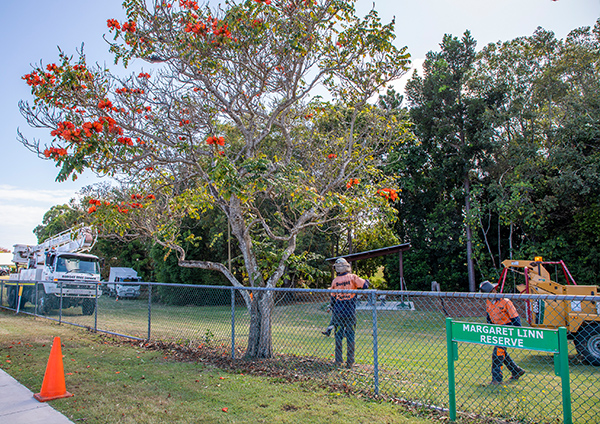Pest trees to be removed from local parks

African tulip trees have been removed from Margaret Lin Park in Kawungan.
The removal is the first stage of a larger program to eliminate the plants from Fraser Coast Regional Council parks and gardens.
“The trees were introduced to Australia and have become a pest,” Fraser Coast Mayor George Seymour said.
“They take over areas and also kill the native stingless bees and other insects.”
The African tulip tree evolved a mechanism to protect its pollen for bats and birds which makes it toxic to native stingless bees and other insects.
The first stage in developing an eradication program is to identify the location of any trees.
“As Council’s Biosecurity Officers move around the region monitoring for pest and weeds they will note the locations of the trees on Council land,” Cr Seymour said.
“The trees will then be programmed for removal as part of Council’s weed management activities.
“Council will look to replace them with more appropriate trees.
“We would love residents to also remove them from their yards to help stop the spread of the trees and protect native bees.”
As an incentive, Council will offer a replacement tree to residents for every African tulip tree removed.
Residents should take a photo of the tree before and after removal and email them to OpenSpace&environment@frasercoast.qld.gov.au to arrange the replacement.
Trees growing within 500 metres of potential native bee habitat and parks with low numbers of trees will be given priority in a removal program, Cr Seymour said.
The African tulip tree is a Category 3 restricted invasive plant under the Biosecurity Act 2014.
The tropical Africa native was popular as an ornamental garden tree or street tree in tropical and subtropical parts of Queensland due to its showy, red tulip-shaped flowers.
African tulip trees are a serious environmental weed in Coastal Queensland, where they are highly invasive and form dense stands in gullies and along streams, crowding out native vegetation.
African tulip trees are extremely harmful to native stingless bees and a public safety hazard (when these trees are planted along footpaths, their dropped flowers can create a slippery walking surface).
The tree will reproduce via seeds and suckers and is very capable of spreading from a single planting.
Areas most at risk include gullies, areas of vegetation around waterways and disturbed rainforest.
Removal of African tulip trees is highly recommended, particularly when they are in close proximity to natural areas.
